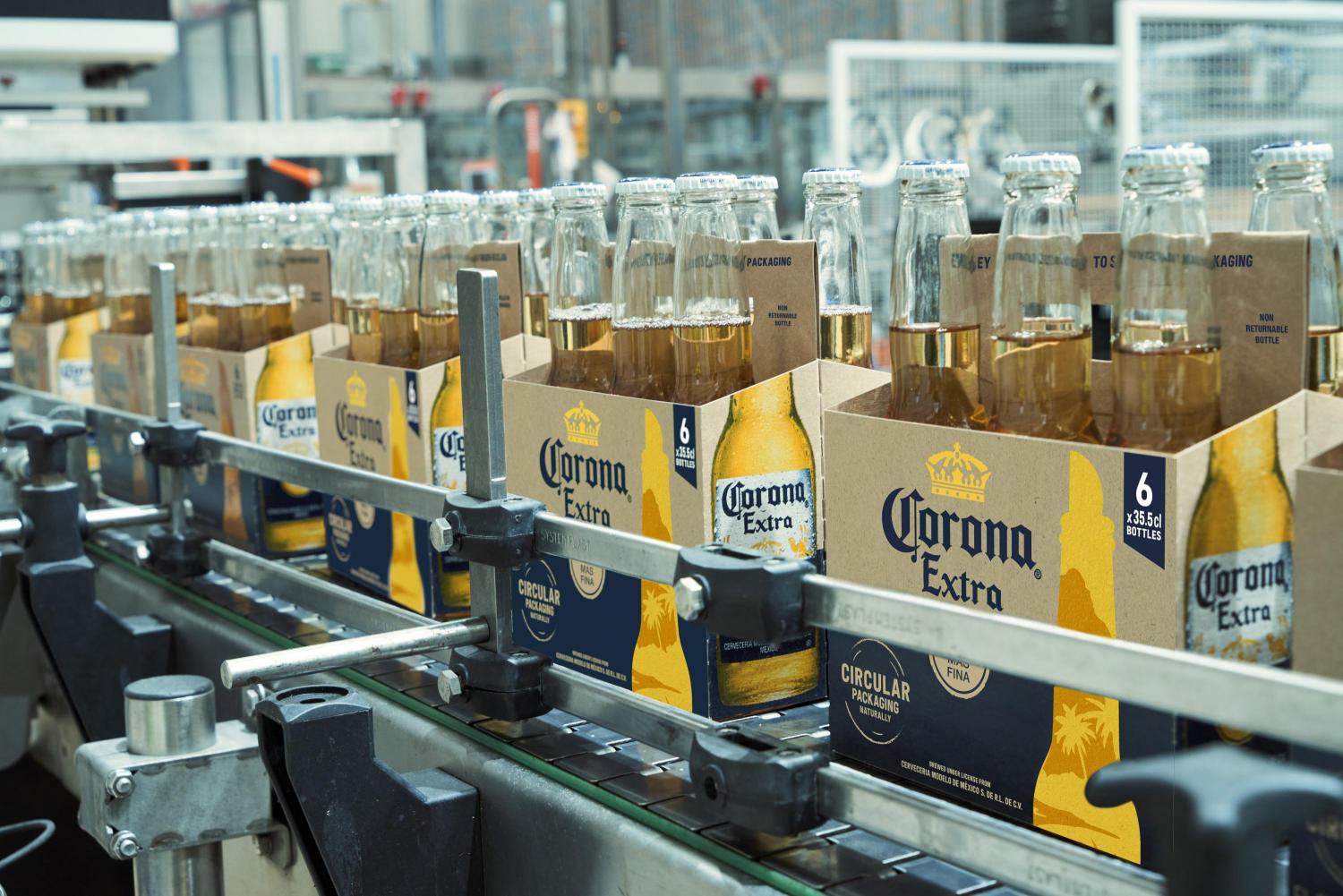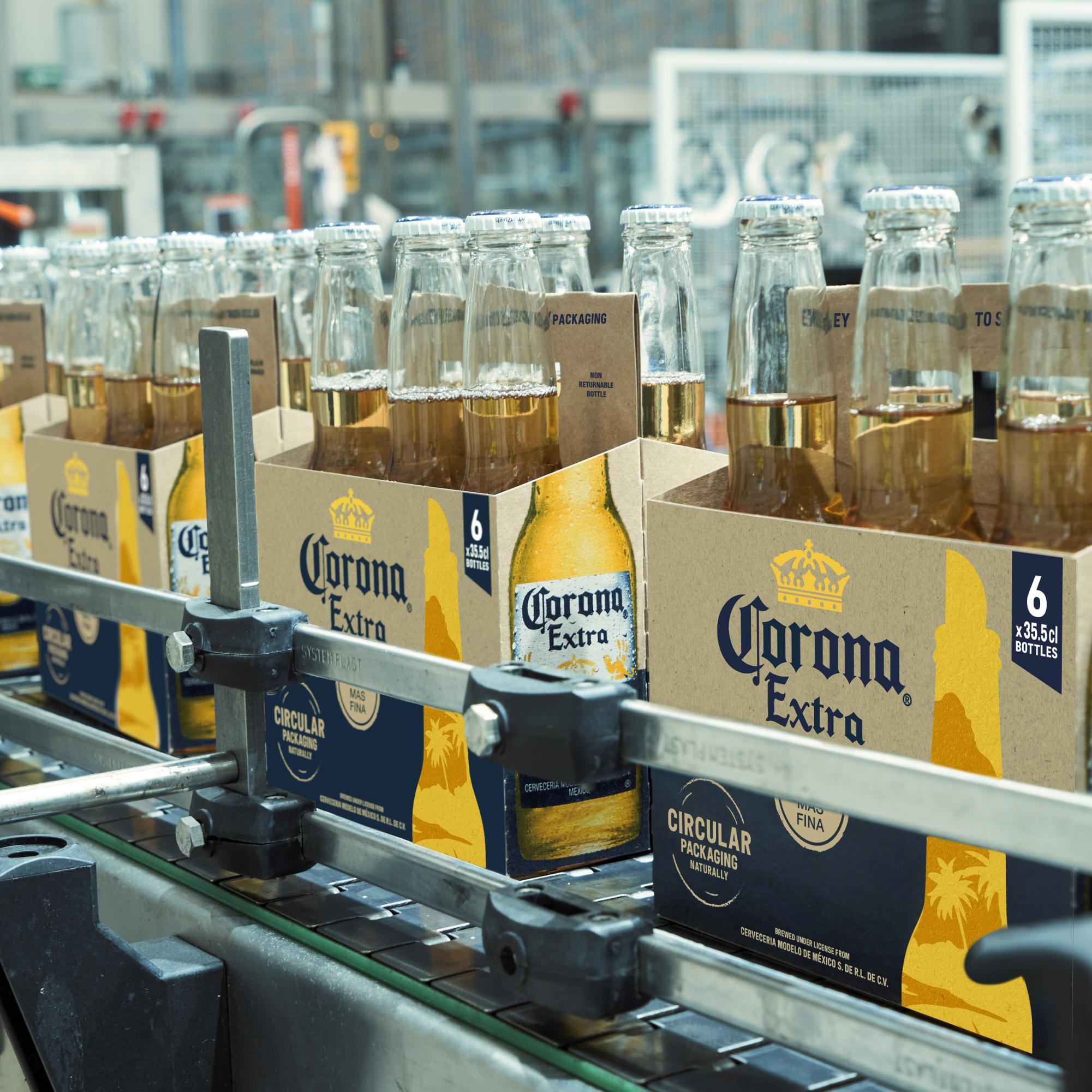Carlsberg, WWF Tackle the Other Deforestation Crisis: Seagrass Loss


Seagrass is one of the more understated carbon sinks available on the planet, but as with much of our globe’s landscape, these marine plants are largely under threat. To that end, the Danish brewer Carlsberg and WWF recently launched a partnership to raise awareness about the benefits of seagrass while trying to prevent even more loss.
According to WWF, what may look like not much more than green shoots coming out of the muck along coastal areas are actually integral to the health of the world’s oceans. WWF says while seagrass only covers 0.2 percent of the oceans’ floors, it absorbs 10 percent of the seas' carbon each year – and it can also capture carbon at a rate 35 times higher than tropical rainforests.
Further, small areas of seagrass can host a huge amount of marine life; WWF touts statistics suggesting an area of just over 100,000 square feet can provide food and shelter to about 80,000 fish and more than a million invertebrates.
As rich as they are in marine life, they are also fragile: a study issued earlier this month concluded the United Kingdom has lost more than 90 percent of its coastal seagrass meadows.
Carlsberg and WWF say they are now working together to raise awareness about this problem. Special editions of Carlsberg packs of beer, many of which have been held together by plastic-free snap packs since 2018, will contribute a donation to help the nonprofit’s seagrass restoration efforts.
Part of that effort started last summer, when WWF worked with volunteers, Sky Ocean Rescue and Swansea University to collect a million seagrass seeds. According to the most recent press reports, about 750,000 of those seeds were planted along the coast of Wales earlier this month; the rest will be planted later this year. The first planting alone, say WWF and its partners, could support 160,000 fish and about 200 million invertebrates.
Image credit: Benjamin Jones/Unsplash
Revenue-Based Financing Gives Social Enterprises Room to Grow and Deliver on Their Mission


The pandemic has brought urgency to solving long-simmering problems with the way social enterprises are funded, especially those led by underserved entrepreneurs. We’ll need companies with community roots and strong social and environmental missions more than ever as we seek to build back a better, more equitable economy. One answer is revenue-based financing, an alternative funding structure that pays investors from future revenues.
Entrepreneurs often complain that venture capital leaves companies little room to maneuver and locks them into a rapid-growth-at-all-costs model. Social enterprise founders may not want to accept venture capital in exchange for ownership rights that could hamper their ability to pursue their mission. Meanwhile, early-stage investors may hesitate to take on substantial risk on companies that, to preserve mission, are less likely to offer investors traditional exits like takeovers and public offerings.
A report developed by the Toniic Institute through its Impact Terms Project (ITP), a library of alternative deal structures, found that alternative structures like revenue-based financing enable underserved entrepreneurs to raise the capital they need to fuel growth and attract additional investment. Revenue-based financing investments work with slower annual revenue growth and lower margins than traditional VC investments require, providing a jump-start to social enterprises and emerging market businesses while meeting investor needs.
Flexible investment for social enterprises
Revenue-based financing allows investors to get returns even when the company is not planning an exit. Instead of getting paid out by new investors, as in an initial public offering, they receive payment from the company over time, which incentivizes them to help the company grow.
Revenue-based financing can be structured as debt or equity, depending in large part on local law, but either structure ties the investor’s returns to the company’s performance. The negotiated return is typically a multiple of the initial investment. The company pays investors a percentage of revenues until reaching a target return.
The faster the company pays money back, the better the investors’ internal rate of return. This has compelling advantages for the company: the timing and size of payments sync up with revenues; there is no dilution to ownership or control since investors don’t take equity or voting board seats; and the company is less likely to suffer a cash crunch.
The ITP team expected that lower minimum revenue growth rate targets would result in higher margin requirements. However, the study found that investment funds willing to accept low forecasted revenue growth in seed-stage companies also will accept low gross margins. Furthermore, they are sector agnostic and can fuel growth in a variety of industries and markets.
Early-stage support for impact-driven business
One case study in the ITP database shows how a Latin American company that makes environmentally friendly cleaning products benefited from revenue-based financing. The company had revenues and positive cash flow, but limited sales and marginal EBITDA, making valuation difficult.
Their investor, an impact fund focused on early-growth social and environmental companies, designed a revenue-based convertible loan to be repaid through an escalating percentage of sales over five years, with an 18-month grace period for principal and interest.
The equity-like structure aligned incentives while allowing the founders to retain ownership and control of its mission while capping the investor’s returns.
Revenue-based financing: an investing instrument for the new normal
Investors see revenue-based financing as an instrument for the post-pandemic new normal. Adobe, a Mexico-based impact investing firm, recently made a handful of revenue-based financing investments to assist struggling social entrepreneurs in Latin America.
“One of the benefits we saw is that these instruments allow the cost of financing to be variable for the company,” said Paula Giraldo, investment officer at Adobe Capital, during a Toniic LatAm virtual panel on impact investing in Latin America, held in November 2020. She said that revenue-based financing also frees investors from performing up-front valuations, which are difficult to do fairly.
Impact terms ease the way for alternative investments
There are many alternative deal structures that balance the needs of investors and social entrepreneurs, and they can be highly tailored to the company’s situation. Both parties need practical guidance about all the options, while their lawyers and advisers need documentation to get comfortable with unfamiliar term sheets.
Toniic’s ITP hosts and maintains a free public database of tools including ready-to-use frameworks, definitions, term sheets and case studies to lower barriers for investors who want to fund solutions to our biggest problems and increase access to capital for early-stage enterprises. Take a look to find a tailored solution for your company—or to submit a new deal to help other social enterprises seeking solutions.
Image credit: Riccardo Annandale/Unsplash
Seeing is Believing: Regenerative Agriculture Scores a Boost from Danone North America


Regenerative agriculture is beginning to gain a stronger foothold in the mainstream market, and the Danone North America family of dairy brands is setting out to accelerate and scale up the trend. The firm’s five-year demonstration program launched just three years ago, and it has already tripled in size, covering over 80,000 acres in the U.S. and Canada.
Bottom line reasons for saving soil, and saving the planet
Danone North America established itself as the largest public benefit corporation on Earth in 2018, and its France-based parent company Danone is staking out a leadership position in sustainable food production. That provides the company with the potential to play a highly influential role in the transition to regenerative agriculture.
Regenerative agriculture is becoming known for its use in preserving soil health as well as building back depleted soil. It shares some characteristics with organic farming, though the two do not necessarily overlap completely. Of the 80,000-plus acres in Danone’s current program, the company says close to 30,000 acres of them are farmed organically as of December.
As Danone explains, there are bottom line and environmental benefits. By improving soil health, regenerative and organic agricultural practices can improve yields, reduce the use of chemicals, restore biodiversity and improve the ability of soil to retain moisture.
The climate crisis adds another level of environmental benefit, and it also opens another pathway for profit. Regenerative agriculture is also gaining force as a carbon sequestration strategy as adding organic matter to soil is a main element in the practice.
Sustainable farming: compare and contrast
Over the first three years of the Danone North America program, the contrast with conventional farming has been striking. For example, conventional farming leaves land uncovered after harvest, which raises the potential for soil depletion. Planting off-season cover crops helps to resolve that problem; two-thirds of Danone’s partner farmers have adopted such practices.
Tilling is another cause of depletion and outright loss, as it exposes more soil to wind. Danone’s partners use reduced or no-till methods on about 80 percent of their lands; nationwide, the average is 37 percent, according to the most recent USDA survey — that is, of farmers who actually report such data in the first place.
Among other strategies that contrast with conventional farming, Danone’s partners have also doubled the species diversity of both cover and cash crops, and they have also invested in additional methods for retaining water in fields.
The climate action benefits are also striking. Danone estimated that the program has avoided more than 80,000 tons of carbon dioxide equivalent and sequestered more than 20,000 tons of carbon.
In addition to food production, regenerative agriculture also has implications for sustainable biofuel production. Some elements of the practice could also become part of broader decarbonization efforts by entities that control large parcels of land, up to and including the U.S. Department of Defense.
A regenerative farming model to follow
Because regenerative agriculture is an emerging field of study, there is much room for experimentation. Still, there is enough knowledge in hand to provide food producers with a reliable roadmap for introducing the practice into their supply chains.
The Danone North America program demonstrates six key elements of a successful regenerative farming program. One is to focus on core benefits, including bottom line benefits. Along with soil health, biodiversity, water, and carbon sequestration, Danone North America cites economy and productivity as important facets of its program.
Another element is to enlist an experienced consultant that can identify science-based benchmarks and set specific goals. Danone deploys the EcoPractices platform developed by its regenerative farming partner, Sustainable Environmental Consultants.
A third element is to track and measure progress on a scientific basis. “The program monitors improved yields and efficiency, and supports the farmer economic value proposition, achieving lower input costs associated with reduced nutrient application, supporting farm economic resiliency as a result of regenerative agriculture practices,” Nicholas Camu, vice president of agriculture at Danone North America, told TriplePundit.
Regenerative agriculture, one farm at a time
A fourth tool in the Danone toolkit is to develop an individual plan for each farm. In a recent email interview with TriplePundit, Camu explained that there is no one-size-fits-all method. In the area of biodiversity, for example, Danone North America and SEC consult directly with each farm. The consultations often result in pilot programs for new cash and cover crops. In effect, the farmer becomes a research partner.
“Agricultural systems can be restored, enhanced or improved in a variety of ways to support improved biodiversity,” Camu said. “This can include adding wildlife boxes and vegetation buffers (such as grasses and trees) which create habitat for pollinators, ground-nesting birds and waterfowl; and even creating wetland areas which can be adjacent to fields to filter nutrients.”
Partnering for global impact
Danone also recognizes that there are many moving parts to both climate action and regenerative farming. Scaling up to a global level is a massive undertaking that requires strategic partners to achieve success.
“We recognize that climate change is a systemic challenge—not in the future, but right here, right now. Globally, we are meeting this challenge head-on by aligning to science-based targets and committing to zero net carbon emissions by 2050. Our zero net carbon commitment means that we are responsible for the carbon emissions from the farms where we source our ingredients to the facilities that manage packaging once our products are consumed,” Camu added.
In support of this effort, Danone North America became a Founding Circle member of the Ecosystem Marketplace Consortium. The non-profit organization has developed a science and market-based strategy for encouraging farmers and ranchers to adopt restorative practices.
Danone has also joined with the influential Renewable Energy Buyers Alliance (REBA) and the Sustainable Food Policy Alliance to advocate for “strong and specific” national policies that “accelerate the transition to a zero-carbon power sector and expand access to clean energy for customers.”
The REBA connection could prove especially interesting. It provides Danone North America with a window into the emerging field of agrivoltaics, in which solar panels are used to provide a shading effect that reduces evaporation and helps to improve soil health.
Always be improving
Finally, the Danone program recognizes that innovation is the driving force behind regenerative agriculture. The company has no plan to rest on its laurels for the final two years of the five-year program. In addition to working with its partner farms on additional improvements and innovations, Danone has articulated a collaborative plan for introducing best practices and models for other companies to adopt, including financial models that enable farmers to invest in new crops, tools, and technologies.
As part of its outreach efforts, Danone has produced a video describing the results of the first three years of the program.
When the fifth year of the program is complete, Danone expects to have 100,000 acres of regenerative agriculture among its partner farms, and many thousands more throughout the global supply chain.
Image credit: Pixabay
Unilever is Paying Brands to Bring Diversity into Their Ad Campaigns


As more women make it clear that it has been long past time for the advertising industry to welcome diversity and inclusion, more organizations are responding in kind. To that end, Unilever recently announced that it will further push advertising agencies to redefine what to many people have become tired and clichéd definitions of beauty.
The latest extension of this work is the Dove brand’s announcement that it will promote more inclusivity in the wider advertising sector by subsidizing the costs of talent if other brands rethink their definitions of what a “model” should be.
Dove’s corporate site in South Africa noted studies finding that as much as 70 percent of women don’t see themselves in advertising and media. “We know from research that if women don’t feel represented, it can hold them back from reaching their full potential,” Sophie van Ettinger of Unilever said in a public statement. “The effects are vast, negatively impacting health, career and relationships. As an actionist brand that continuously challenges narrow beauty ideals, it is our duty to help others to represent all beauty in their advertising.”
The work started two years ago when Dove launched Project #ShowUs in partnership with Getty Images and the creative network GirlGaze. Together, the organizations collected over 10,000 images of women who comprise a “more inclusive vision of beauty,” and made them available for any media and advertisers. These photos have not been altered or airbrushed in any way.
Now, Dove South Africa says it wants to take this movement further. The brand describes the effort as hacking the advertising industry from the inside. Models offered a simple message to casting directors: “If you choose me, and show me as I really am, Dove will cover the cost of my appearance fee.”
Brands that have made the decision to work with these models include the French cleaning products company Cif, donut chain Krispy Kreme, ice cream maker Magnum, and South African financial services firm Nedbank.
“There is different kinds of beauty, all of it deserves to be shown, all of it deserves to be represented in the right kind of way,” said Mpho, one of the models who participated in this initiative and who ended up working with Magnum on one of its ad campaigns.
The offer to not only work with these aspiring models, but even pay to have them appear in other companies’ campaigns builds upon additional recent work by Dove and Unilever on this front. For example, Unilever announced earlier this month it would remove the word “normal” from all of its brands’ personal care and beauty products after research the CPG giant commissioned revealed that, more often than not, the term connotes negativity and makes consumers feel excluded.
Image credit: Dove South Africa
Is ESG Investing Poised to Take Another Giant Leap Forward?


The electronics giant Samsung announced in late February that it was redoubling its efforts toward environmental, social, and governance (ESG) initiatives, offering one more piece of evidence of just how seriously corporate sustainability, and ESG investing, are now regarded.
Indeed, Samsung’s mission, as stated by Executive Vice President Jaeho Shin, is to “further evolve into a global company that earns trust from our customers and members of society, and that dedicates to the development and happiness of humanity.” Doing so is “no longer optional” according to a February 22 note issued by Goldman Sachs, which cited European regulations and the ESG advocacy of the new U.S. president, Joseph R. Biden, as the primary reasons for the uptick.
But even before Biden took office or those regulations took shape, ESG had taken center stage. A study by the Chartered Financial Analyst (CFA) Institute showed that in 2020, 85 percent of that organization’s members took ESG into consideration and that 65 percent of their clients demanded that they do so.
Moreover, nine of every 10 investment professionals believe that going forward, their firms will delve more deeply into ESG, though that contrasts markedly with the number of institutional and retail investors who actually consider ESG investing. Those respective numbers stand at 19 percent and 10 percent, according to the survey.
One of the primary issues affecting ESG investing is those businesses that engage in “greenwashing,” whereby they portray their products as being more environmentally compliant than they might actually be. That speaks to one of the primary concerns surrounding surging interest in ESG investing: a lack of consistent, reliable data to measure such compliance. Fully 78 percent of those responding to the CFA survey pointed out a need for uniform standards.
In fact, the report concluded, enterprises are often “left to determine for themselves which ESG factors are material to their business performance and what information to disclose to investors.” An example would be the Morgan Stanley Composite Index (MSCI), which measures companies’ commitment to various environmental and social initiatives, as well as corporate governance.
As mentioned, there is every expectation that the Biden administration will address the issue of uniformity -- that in particular, the appointment of Gary Gensler as head of the Securities and Exchange Commission will change the landscape. As an advisor to Senator Paul Sarbanes, he helped draft the Sarbanes-Oxley Act of 2002, which called for managerial oversight of companies’ financial reporting on the part of business leaders, and severe penalties for those CEOs who failed to comply.
The expectation is that similar standards will be applied to ESG disclosure. In addition, the asset manager BlackRock, besides issuing a request to companies to reveal their plans for going net-zero, is banding together with State Street and Vanguard to encourage enterprises to abide by the reporting standards set forth by the Sustainability Accounting Standards Board (SASB), a nonprofit organization formed in 2011 with such transparency in mind.
In the private sector, multiple companies have attempted to introduce data-driven ESG analytics to analyze companies and portfolios. Some, like investment bank Schroder’s, which has built SustainEx, rely on in-house tools. Others, like New York-based Vestive, are providing third-party tools to attempt to provide greater clarity for investors.
In addition, Nasdaq is mulling an amendment that would require companies to make diversity disclosures - specifically, as it pertains to directors - part of its listing standards, as such social concerns were brought to the forefront by the Black Lives Matter movement in 2020.
Finally, the International Financial Reporting Standards (IFRS) Trustees announced in February that it is moving forward with the idea of forming a new board that would establish global ESG reporting standards, in hopes of a proposal being finalized in September and the board’s formation being announced at the United Nations Climate Change Conference in November.
In the meantime, companies can expect continued pressure from stakeholders and investors regarding ESG, as was the case in 2020 when major oil companies were challenged to meet emissions targets. As BlackRock chairman Larry Fink noted in a January 2021 letter to CEOs, “There is no company whose business model won’t be profoundly affected by a transition to a net-zero economy” by 2050. As a result, Fink added, it would behoove businesses to formulate a “well-articulated long-term strategy” that moves the company toward this goal while assuaging investors.
Climate initiatives have long been front and center and will understandably remain so. But the other facets of ESG investing will likewise continue to demand attention, as will the ongoing quest to establish uniform reporting standards. The latter is of particular importance, as that will ensure transparency and adherence to the larger goals of ESG.
Image credit: MayoFi/Unsplash
'This Girl Can' Aims to Make Images of Female Fitness More Accessible and Inclusive


Many fitness-related images we see impart the message that yes, this girl can. The problem is that usually it is just one certain demographic of young women are shown in them.
Since the pandemic started last year, it seems as if the amount of fitness-related social media ads have doubled – if not tripled – in quantity and frequency. Almost all of the posts feature young, seemingly able-bodied, thin white women in coordinated sports bra and leggings sets, smiling while riding a Peleton or doing yoga. The unglamorous realities of “exercising while female” – sweat, cellulite, arm jiggling, kids underfoot, post-baby bodies, hormonal changes and ill-fitting workout gear – are nowhere to be found.
Sport England’s This Girl Can initiative seeks to “help address the misrepresentation of images used in marketing and the media” with a new free image library celebrating women exercising and practicing healthy habits.
The image library – introduced earlier this month on International Women’s Day – was inspired by a recent study conducted by This Girl Can. At least 63 percent of women interviewed said that “seeing slim, toned bodies on social media sites has a negative impact” on how they view themselves.
The study also examined existing stock imagery on the web, analyzing the first 100 photos listed in a Google image search of the phrase “women exercising.” Not surprisingly, 85 percent of the results were of women who appeared to be a U.S. size 6 (U.K. size 10) or smaller. Seventy percent of the women were white, 65 percent looked younger than 35, and only 2 percent appeared to be “out-of-breath, sweaty or red-faced.”
The new This Girl Can stock image collection, however, features women from infants to seniors, of all different body shapes and sizes. There are women with hijabs, women with tattoos, and women who are very pregnant. There are women using adaptive mobility equipment such as walkers. There are even women who are – gasp – sweating!
As of press time, there were almost 1,000 royalty-free images available in the new collection.
“Our aim is to inspire women to become more active and showcase the many fantastic ways they can do so,” said Kate Dale, the campaign lead of This Girl Can, in a release from Sport England. “We know there are barriers women have to exercise, fears of judgment and feeling that they will fail. We are encouraging behavioral change, which can be difficult if women’s misconceptions are often reinforced on a daily basis by the imagery they view in media, advertising and online.”
For six years, This Girl Can has spread the message that exercise is accessible to all. Not only has the campaign inspired hundreds of thousands of women and girls to get active, but it also has opened up national – and international – dialogue over many issues not often discussed by the sports media. For example, the organization’s 2020 video (released shortly before the pandemic) showed a disabled woman using a lift to get into a swimming pool, a woman breastfeeding before playing basketball, and a woman working out to alleviate her menstrual cramps.
This Girl Can is not the only one bringing more women in fitness into the conversation around fitness and sports. Earlier this month, Olympic medalists Sue Bird, Chloe Kim, Simone Manuel and Alex Morgan launched Togethxr, a media company focused on sharing female athletes’ stories through videos, podcasts and photography. Also debuting this month, Nike’s latest ad for its maternity line features pregnant women (obviously), along with a mother pumping breastmilk, a mother in labor and mothers of infants of toddlers.
With changes like these, there is some hope that women’s fitness struggles and successes will finally get the attention they deserve.
“COVID has shown how quickly women sacrifice their own exercise time to care for others,” Dale said in a recent interview with RWL Magazine. “Women need to know now, more than ever, that they are still very much part of the home exercise conversation.”
Image credit: This Girl Can Image Library
For Corona, Barley Is For More Than Beer


The popular beer brand Corona says it is testing out new six-back holders containing barley straw mixed with 100 percent recycled wood fibers.
From a brand perspective, 2020 was a trying year for Corona (for obvious reasons), but the ever-popular beer proved to not only survive but thrive during the pandemic. Not only are sales up overall, but the company continues to launch new drinks and it is also trying out new, more sustainable packaging.
The brand’s latest development is a more circular form of fiber-based packaging for its six-packs of bottles. This new six-back holder contains barley straw mixed with 100 percent recycled wood fibers. As with many ales, barley is an important ingredient in the brews made by Corona; now some of that straw that farmers often discard after harvesting barley will be put to another use.
According to AB InBev, the parent company of the Corona brand, churning barley straw into cardboard fiber is a process the requires up to 90 percent less water than using virgin wood – and also requires far less energy and chemicals. And when it comes to land use, far less acreage is also needed.
The new packaging builds upon Corona’s previous ventures to eliminate wasteful and even harmful packaging, such as the six-pack rings for aluminum cans made from waste byproducts including that of barley.
But Corona serves up far more beer out of its iconic glass bottles then cans, so these new six-pack holders could have a larger impact in the long run. AB InBev said in a public statement that it would consider rolling out the barley-based packaging across more of its brands.
It could be a while before you see this packaging in North America – especially as Constellation Brands owns the rights to Corona here in the U.S. For now, AB InBev is piloting the new packaging in Colombia, and will then introduce it in Argentina later this year. For anyone asking why it could take so long, keep in mind that AB InBev said this new packaging option was three years in the making.
Image credit: Corona/Business Wire
As Coal Market Shrinks, CSX Pledges Transparency on Climate Lobbying


The U.S. railroad industry has spent many years building up its image as a sustainability leader. However, the veneer of “green” hides an aggressive history of lobbying against climate action. Now the wall of denial appears to have grown a massive crack. The leading rail company CSX has just agreed to disclose its lobbying activities as an important step towards a more consistent and meaningful sustainability policy.
U.S. railroads are green on the outside…
Railroads have a built-in advantage on climate action, due to the fuel efficiency of rail transport.
“Trains can move a ton of freight more than 450 miles on a single gallon of fuel,” CSX notes, adding that “Efficient use of fuel means less greenhouse gases or carbon emissions for our planet.”
Still, there is always room for improvement. CSX set a relatively modest emissions reduction goal in 2012, and the company has ramped up its goal considerably since then. Just last year, CSX became the first rail company in North America to gain approval from the global Science Based Targets initiative (SBTi).
“CSX will reduce greenhouse gas emissions intensity by 37.3 percent between 2014 and 2030,” CSX stated. “The company expects future transformational technology to facilitate this next level of reductions and is extensively investing in technologies and operational practices that drive maximum achievable efficiencies.”
…not so much on the inside
Unfortunately, the impact of CSX’s commitment to climate action begins to crumble in the context of its trade group ties, including the Association of American Railroads.
In 2019, The Atlantic reporter Robinson Meyer detailed the findings of two recent studies on the lobbying activities of the Association of American Railroads. He describes a decades-long trail of anti-science activities rivaling that of ExxonMobil in its scope and impact.
“The four largest American freight railroads - BNSF Railway, Norfolk Southern, Union Pacific, and CSX - have sat at the center of the climate-denial movement nearly since it began,” Meyer wrote. “These four companies have joined or funded groups that attacked individual scientists, cast doubt on scientific consensus, and rejected reports from major scientific institutions, including the United Nations–led Intergovernmental Panel on Climate Change.”
Follow the money
The record of climate science denial clashes with the fuel efficiency profile of railroads, but it is fully consistent with the railroad industry’s reliance on the coal industry.
“Nearly 70 percent of American coal is shipped by rail, often along ‘dedicated’ lines that can ‘operate around the clock, the rail association says on its website,” Meyer wrote. “The largest class of railroads made a combined $10.7 billion, or 14 percent of their revenue, hauling coal last year.”
CSX is a case in point. As described on its own website, CSX is “the largest coal transporter east of the Mississippi River.”
The company also outlines its role in the global coal industry, explaining that it “provides service from the largest number of active coal origins, seamlessly interchanges with Western railroads and short lines, and provides access to multiple Eastern seaports.”
“Our specialized unit train service creates an efficient pipeline that allows us to move more than 130 - 165 million tons of coal products per year,” CSX states, listing coke and petroleum coke among the coal-related products it carries.
Making a real commitment to climate action
Apparently, CSX has begun to see the writing on the wall. Globally and here in the U.S., coal is losing its once-mighty grip on the power generation sector due to the advent of low-cost natural gas and renewable energy.
Steel manufacturers and other energy-intensive industries are also beginning to ease their dependence on coal, with an assist from new green hydrogen technology. In addition, new plastic recycling technology and bio-based alternatives are beginning to replace coal, petroleum and natural gas in the chemicals industry.
The election of President Joe Biden on an aggressive decarbonization platform may have also sparked CSX into action. Earlier this week, the sustainable investment firm Green Century Capital Management announced that it has withdrawn a shareholder resolution with CSX, following a new transparency pledge by the company.
The resolution was spearheaded by the Unitarian Universalist Association and supported by the Interfaith Center on Corporate Responsibility.
“Green Century has withdrawn a shareholder resolution with CSX Corporation (CSX) after it agreed to report on any of its lobbying activities, and those of its trade associations, that contradict the goals of the Paris Climate Agreement,” the firm announced, while calling out the Association of American Railroads by name.
“These new commitments signal that the company is ready to address the material risks posed by the climate crisis and end its support for lobbying that does not align with its climate destination,” Green Century President Leslie Samuelrich emphasized.
A new direction for CSX and its competitors
The pledge calls for CSX to review its lobbying practices and those of its trade associations alongside its climate policies, and to report on any discrepancies.
Regardless of its past practice, those trade associations may already be pivoting to adopt new business models that offset the loss of coal freight and other forms of fossil energy.
The American Association of Railroads, for one, appears eager to cannibalize the trucking industry for new opportunities to make up for the loss of coal traffic.
Last summer, the trade group issued a white paper that “contextualizes how and why freight rail provides a solution that helps decrease the country’s carbon emissions and reduces transportation’s overall environmental impact.”
The analysis looked at two scenarios for replacing long haul truck transport of at least 750 miles with rail transport. Under a 25 percent replacement scenario, the analysis finds a fuel savings of 1.2 billion gallons, leading to a reduction of approximately 13.1 million tons in greenhouse gasses.
That savings could diminish as the long haul trucking industry electrifies. However, the analysis does suggest that the coal industry is beginning to lose a key ally as CSX, and other railroad stakeholders, adapt to a more sustainable future.
Image credit: Benjamin Wagner/Unsplash
How Morgan Stanley Strives to Alleviate the Pandemic’s Mental Health Impact on Children


Depressive and anxiety disorders are rising among children and youth in the U.S. and the COVID-19 pandemic together are accelerating what has become a mental health crisis. Children are facing disruptions in their daily lives including isolation, food insecurity and financial changes. The results are influencing their mental health and from some mental health professionals, depression and anxiety have become a bigger concern for them than the virus itself. During the pandemic, more than 50 percent of children have felt moderately sad, depressed or unhappy relative to 25 percent of adults, according to at least one study.
Children's mental health has reached a breaking point
As more companies are now working to alleviate the pandemic’s impact on mental health, Morgan Stanley says it has been investing in children’s mental health for over 50 years. Further, in February 2020, Morgan Stanley established the Morgan Stanley Alliance for Children's Mental Health in response to rising concerns over rising concerns over children's mental health and related challenges. This synergy between Morgan Stanley's resources and expertise of its non-profit partners aims to help youth, especially those within marginalized communities. Child Mind Institute is among the founding non-profit partners of this alliance.
“There’s almost none or very few corporate players in this space but I think from a societal perspective, there is actually a dearth of spending there so it’s definitively in need,” said Joan Steinberg, the company’s global head of community affairs and President of the Morgan Stanley Foundation, in a recent interview with 3p. “It’s an underfunded area in every way you can imagine.”
Extensive research on mental health points in one direction
In response to this crisis, Morgan Stanley launched more research and surveys on children’s mental health in 2019. These efforts, says the company, were made to enhance children’s quality of life and understand where exactly in children's health can the company prevent death and diseases. The situation in dire: In 2018, the second leading cause of death for individuals between the ages of 10 to 34 was suicide.
The company continued its research with a follow-up study in November 2020, which confirmed the initial findings: Disruption in daily life is detrimental for both children’s and adults' mental health.
Morgan Stanley is continuing its efforts today. Earlier this year, the company announced a $250,000 grant to support research studies from Child Mind Institute. These studies aim to raise awareness and help develop intervention strategies for children's mental health issues during the pandemic. This grant is one extension of the company’s CRISIS (Coronavirus Health and Impact Survey) project.
Combating institutional challenges and stigma
While financial support kickstarts preliminary research, challenges in children obtaining mental health support exists in access, socio-economic barriers and stigma. To eliminate these challenges and the stigma attached, Morgan Stanley is focusing on education in high schools and colleges as well. More specifically, one of the alliance’s founding non-profit partner is The Jed Foundation (JED), which has established student mental health programs across campuses.
“There are some hard-core infrastructure issues that have to be addressed and no one company is going to solve that problem. That’s going to take a lot more listening than just us but we can do a lot to raise awareness and reduce stigma as a corporation,” Steinberg told 3p. Institutional challenges include the lack of psychiatrists and psychologists in the U.S, especially in rural areas. This scarcity paired with financial constraints, long commutes and family members working multiple jobs are burdensome when obtaining mental health support.
To measure the effectiveness of its efforts, Morgan Stanley has key performance indicators to measure the company’s impact and how far and in-depth children are reached and parents are educated. The company is also measuring success through obtaining additional funding and influencing other corporations to participate.
“Certainly, we’re looking to see that other funders start joining us and what other corporations, whether private, foundations can we bring to the table, it’s really important to us,” added Steinberg.
Reducing stigma, emphasizing education and encouraging participation is setting the foundation for long-term solutions to a rising problem. As COVID-19 exacerbates mental health issues, especially those of children, the pandemic has made one thing very clear: Children’s mental health cannot be ignored and it is an area in which corporations can contribute resources to help take on this crisis.
Image credit: Ketut Subiyanto/Pexels
Georgia Voter Suppression Bills Challenge Pro Sports Franchises to ‘Rise Up’


Photo: A Black Lives Matter protest in Atlanta, Georgia, in 2020. Almost a year later, lawmakers are pushing legislation that would result in voter suppression across the Peach State.
In the run-up to election day in 2020, Georgia’s professional basketball, baseball, football and soccer organizations helped to amplify nationwide get-out-the-vote efforts. The Atlanta Falcons’ high-profile “Rise Up and Vote” game on Oct. 25 is just one example. Now, their commitment to free and fair elections is facing a new test, as state lawmakers push legislation that makes Georgia the face of state-sanctioned, race-based voter suppression in America.
So far, Georgia’s professional sports teams have kept out of the fray. However, money talks, and the fate of new sports betting legislation may stir them into action.
Georgia becomes the face of voter suppression in America
More than 250 voter suppression bills are circulating in Republican-controlled statehouses this year, and Georgia has become a particular focus of attention. With the state’s legislative session set to end on March 31, all eyes are on a series of Republican-sponsored bills aimed at making it harder for many Democratic-leaning Georgia voters to cast a ballot.
The voter suppression bills have already provoked a massive pushback from voting rights advocates in Georgia, who have been leaning on the state’s leading corporate citizens to take a stand.
Most of the pressure has focused on such Georgia-based companies as Aflac, Coca-Cola, Delta Air Lines and Home Depot. All of these companies eventually responded by issuing statements in support of voting rights in general. However, they mostly fell short of criticizing specific elements in the proposed legislation, including new ID requirements and restrictions on early voting and vote-by-mail ballots.
Editor's note: Be sure to subscribe to our Brands Taking Stands newsletter, which comes out every Wednesday.
One company speaking out is Salesforce. The company was not among the first to issue a statement, but it finally came through on March 16 and targeted specific legislation.
“A person’s right to cast their ballot is the foundation of our democracy,” Salesforce wrote on its official Twitter account. “Georgia HB 531 would limit trustworthy, safe & equal access to voting by restricting early voting & eliminating provisional ballots. That’s why Salesforce opposes HB 531 as it stands.”
The Metro Atlanta and Georgia Chambers of Commerce have also spoken out against the voter suppression legislation.
Sports betting is also on the line
The corporate response may be too little, too late to help prevent voter suppression legislation from reaching the desk of Georgia Gov. Brian Kemp. Now, the pressure is on the governor to exercise his veto power.
In an interesting twist, voting rights advocates may be able to leverage sports betting to sway his pen.
Earlier this month, reporters Greg Bluestein and Tia Mitchell of the Atlanta Journal-Constitution took note of that development (emphasis added).
“One potential casualty is a measure to legalize sports betting that requires bipartisan support and that seemed, to some supporters at least, on the cusp of success in Georgia,” they wrote. “The House vote on the issue last week was delayed by Democratic leaders who say they’re withholding support both to demand new concessions, such as provisions for minority vendors, and also to protest the elections restrictions.”
That is where Georgia’s professional sports leagues come in.
Bringing legalized online sports betting to Georgia has been a decades-long effort on the part of its supporters. All four of the state’s leading professional sports franchises recently stepped up the pressure to push it over the finish line.
Under the banner of the Georgia Professional Sports Integrity Alliance, the Atlanta Braves, Falcons, Hawks and United organizations have pumped more than $272,000 into state campaigns in support of bills legalizing online and mobile sports betting since 2019.
When will pro sports “rise up” and push back against voter suppression?
With the coveted prize of legalized online sports betting finally in view, Georgia’s pro sports franchises are most likely doing their best to avoid ruffling feathers in the statehouse, or in the governor’s office. That could explain why they have failed to take a stand on the voter suppression bills.
However, the situation is dripping with irony compared to their get-out-the-vote activities last year.
The Atlanta Falcons, for example, promoted the aforementioned “Rise Up and Vote” game with a message from franchise owner Arthur M. Blank. He specifically lauded the role of early voting and vote-by-mail, the very elements now targeted by Republican lawmakers to suppress the vote.
The United FC, another franchise under the Blank umbrella, used the same message in support of the team’s 2020 voter registration drive. The Atlanta Falcons went a step farther, donating the use of their venue for early voting in advance of election day.
The Atlanta Braves were notably absent from a voter drive rundown promoted by Major League Baseball leading up to election day. However, the Braves, like the other three franchises, did promote Black History Month this past February.
This month, professional sports franchises in Georgia have a chance to make history and take a stand against voter suppression. But the clock is ticking.
The ball is in their court.
Image credit: Ben Dutton/Unsplash